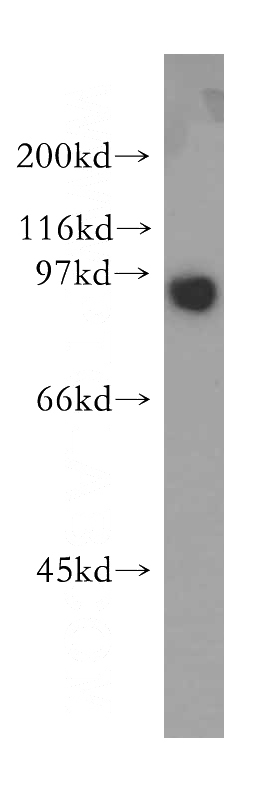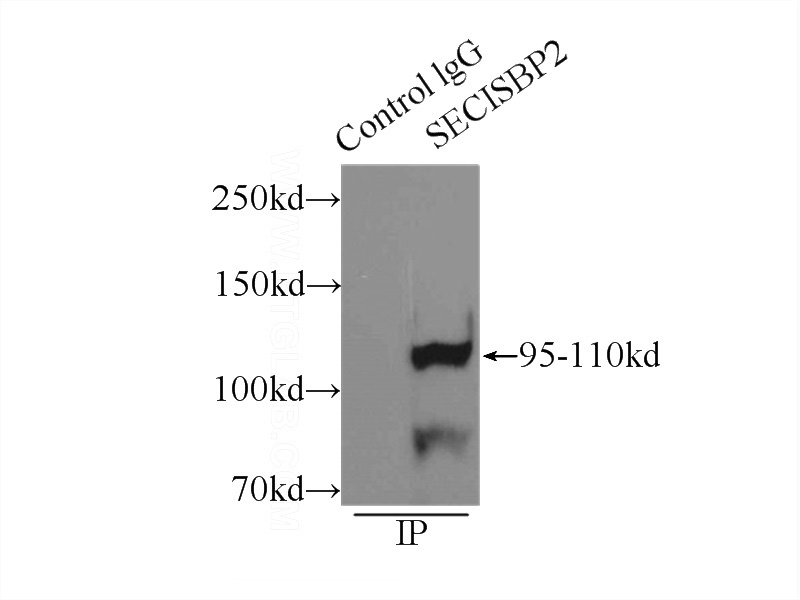-
Product Name
SECISBP2 antibody
- Documents
-
Description
SECISBP2 Rabbit Polyclonal antibody. Positive IF detected in HeLa cells. Positive WB detected in HeLa cells, human kidney tissue, Jurkat cells. Positive IP detected in mouse testis tissue. Observed molecular weight by Western-blot: 95 kDa
-
Tested applications
ELISA, WB, IP, IF
-
Species reactivity
Human,Mouse,Rat; other species not tested.
-
Alternative names
DKFZp686C09169 antibody; SBP2 antibody; SECIS binding protein 2 antibody; SECISBP2 antibody
- Immunogen
-
Isotype
Rabbit IgG
-
Preparation
This antibody was obtained by immunization of SECISBP2 recombinant protein (Accession Number: XM_047423856). Purification method: Antigen affinity purified.
-
Clonality
Polyclonal
-
Formulation
PBS with 0.1% sodium azide and 50% glycerol pH 7.3.
-
Storage instructions
Store at -20℃. DO NOT ALIQUOT
-
Applications
Recommended Dilution:
WB: 1:500-1:5000
IP: 1:200-1:2000
IF: 1:20-1:200
-
Validations

HeLa cells were subjected to SDS PAGE followed by western blot with Catalog No:115092(SECISBP2 antibody) at dilution of 1:400

IP Result of anti-SECISBP2 (IP:Catalog No:115092, 3ug; Detection:Catalog No:115092 1:600) with mouse testis tissue lysate 8000ug.

Immunofluorescent analysis of HeLa cells using Catalog No:115092(SECISBP2 Antibody) at dilution of 1:50 and Alexa Fluor 488-congugated AffiniPure Goat Anti-Rabbit IgG(H+L)
-
Background
Selenium (Se) is an essential trace element required for the biosynthesis of selenoproteins, and selenocysteine insertion sequence (SECIS) binding protein 2 (SECISBP2, or SBP2) represents a key trans-acting factor for the cotranslational insertion of selenocysteine into selenoproteins. Defects in SBP2 are a cause of abnormal thyroid hormone metabolism (ATHYHM) associated with a reduction in type II iodothyronine deiodinase activity. Mutations in this gene have been associated with a reduction in activity of a specific thyroxine deiodinase, a selenocysteine-containing enzyme, and abnormal thyroid hormone metabolism. Cells depleted of SBP2 have increased levels of ROS, which lead to cellular oxidative stress manifested as DNA lesions, stress granules, and lipid peroxidation, induction of caspase- and cytochrome c-dependent apoptosis, indicating that SBP2 is required for protection against ROS-induced cellular damage and cell survival.
-
References
- Legrain Y, Touat-Hamici Z, Chavatte L. Interplay between selenium levels, selenoprotein expression, and replicative senescence in WI-38 human fibroblasts. The Journal of biological chemistry. 289(9):6299-310. 2014.
- Touat-Hamici Z, Legrain Y, Bulteau AL, Chavatte L. Selective up-regulation of human selenoproteins in response to oxidative stress. The Journal of biological chemistry. 289(21):14750-61. 2014.
- Lin HC, Ho SC, Chen YY, Khoo KH, Hsu PH, Yen HC. SELENOPROTEINS. CRL2 aids elimination of truncated selenoproteins produced by failed UGA/Sec decoding. Science (New York, N.Y.). 349(6243):91-5. 2015.
Related Products / Services
Please note: All products are "FOR RESEARCH USE ONLY AND ARE NOT INTENDED FOR DIAGNOSTIC OR THERAPEUTIC USE"
